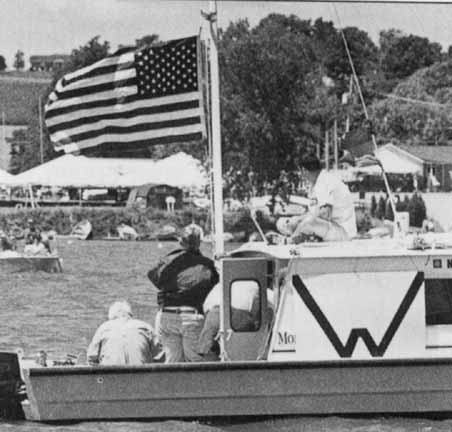
WIND INDICATORS
USE THESE CLUES TO PREDICT THE WIND
BY DAVE DELLENBAUGH
The ability to forecast what the wind will do is one of the biggest keys to success in sailboat racing. If you want to be successful at this, you must gather a lot of information about the wind direction and velocity.
Fortunately, there are many clues to help you forecast the immediate and longer term wind trends. You can (and should) use these both before and after the start to help in planning your strategy. Her is a checklist of things to do and places to look:
• Monitor recent wind readings. The best way to predict what the wind will do in the near future is to understand what it’s done in the recent past. Try to decipher trends and extrapolate into the future.
• Keep an eye on wind shear. When the wind is blowing a different direction at the top of your mast than it is at water level, this often indicates an impending windshift toward the direction of the shear.
• Get weather information. Listen to your weather radio and check relevant web sites. Keep in mind, though, that this is very “big-picture” stuff. Call the nearby airport for better information, or use a weather service.
• Watch the wind on the water. Assign one crewmember to watch the texture and color of the water to windward all the time. Get as high as possible by standing on deck or on the boom (or even going up the rig). Be sure to monitor this during the critical 10 minutes before your start.
• Look at boats to windward. Racing boats (especially other fleets that start ahead of you) are great indicators of changes in both wind pressure and direction. Cruisers show lifts well, but don’t use the for headers since they usually sail below your normal upwind angle anyway. Look at heel angle on any boat for clues about wind velocity.
• Watch “telltales” to windward. These include smoke from smokestacks, flags on shore, flags on stake or committee boats, the swing of anchored boats, and so on. See if you can discern any pattern between the action of these telltales and subsequent changes in the wind.
• Track the windward mark. Watch where the race committee sets (or moves) the windward mark. If it is not directly into your sailing wind, they may have information (e.g. wind readings from a mark boat or a weather report) that the wind has shifted or will shift.
• Watch the other boats in your fleet. These are often the best telltales, especially when they are on opposite sides of the course. Any time you cross near another boat, keep an eye on them the next time you come together to see if you have gained or lost.
• Keep a log. Record wind data and observations every time you go sailing. This is the best way to learn about, remember, and therefore predict changes in the wind due to local geographic effects.
• Feel the waves. Sometimes an impending windshift will show up first in the form of waves coming from a new direction.
• Keep an eye on the clouds. Movement and formation of the clouds is often your best giveaway for what the wind will be doing.
 |
VISUAL CLUES: Other sailboats are like giant wind pennants to help you “see” the invisible wind. Besides these aids, here are a number of other visual clues for gathering information about the wind:
Anchored flags. Watch flags or wind pennants on the race committee boat, moored boats or flagpoles on the shore. Just remember that these fixed flags will not show the wind effects of current.
Unanchored flags. The flags on a drifting stake boat or mark boat can be a great resource. These include current wind, but don’t use them if the boat is moving at all.
Smoke from smokestacks. This great resource can give you wind info from a long distance. Remember, though, smoke doesn’t include current effects, and it shows the wind up high, which is often different from your sailing wind.
Wind ripples on the water. These are great for seeing relative wind pressure, but they aren’t so good for spotting shifts in direction. Don’t be fooled by the following:
—The glare of the sun will affect the ripples’ appearance. If you’re looking toward the sun, the sparkles will usually make it look like there’s more wind than when you’re looking away from the sun.
—When you’re looking upwind, the ripples make it look like there’s more wind than when you’re looking downwind.
Dave is a two-time America’s Cup veteran who publishes a newsletter Speed & Smarts. For a subscription call: 800-356-2200.